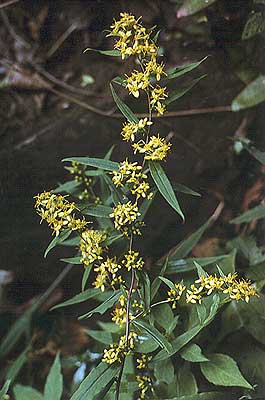Additional Information
The Latin name is a cimbination of solidus and ago, meaning "I make whole", a reference to its long history as an herbal remedy. Goldenrod has antioxidant, diuretic, and astringent and antifungal properties and is said to be especially useful in treating urinary tract and yeast infections, as well as sore throats and diarrhea.
Both the roots and flowers were used medicinally by Native Americans, who also boiled the flowers of various species to make a yellow dye. Thomas Edison hoped to make a rubber substitute from the rubbery sap of the goldenrod. Although these uses are no longer valid, the goldenrod's usefulness to countless species of birds, butterflies, and other insects is significant. Interestingly, a variety of tiny insects use small galls formed on the stems, leaves and even roots of the goldenrod to shelter their growing larva.
 Blue-stemmed Goldenrod
Blue-stemmed Goldenrod